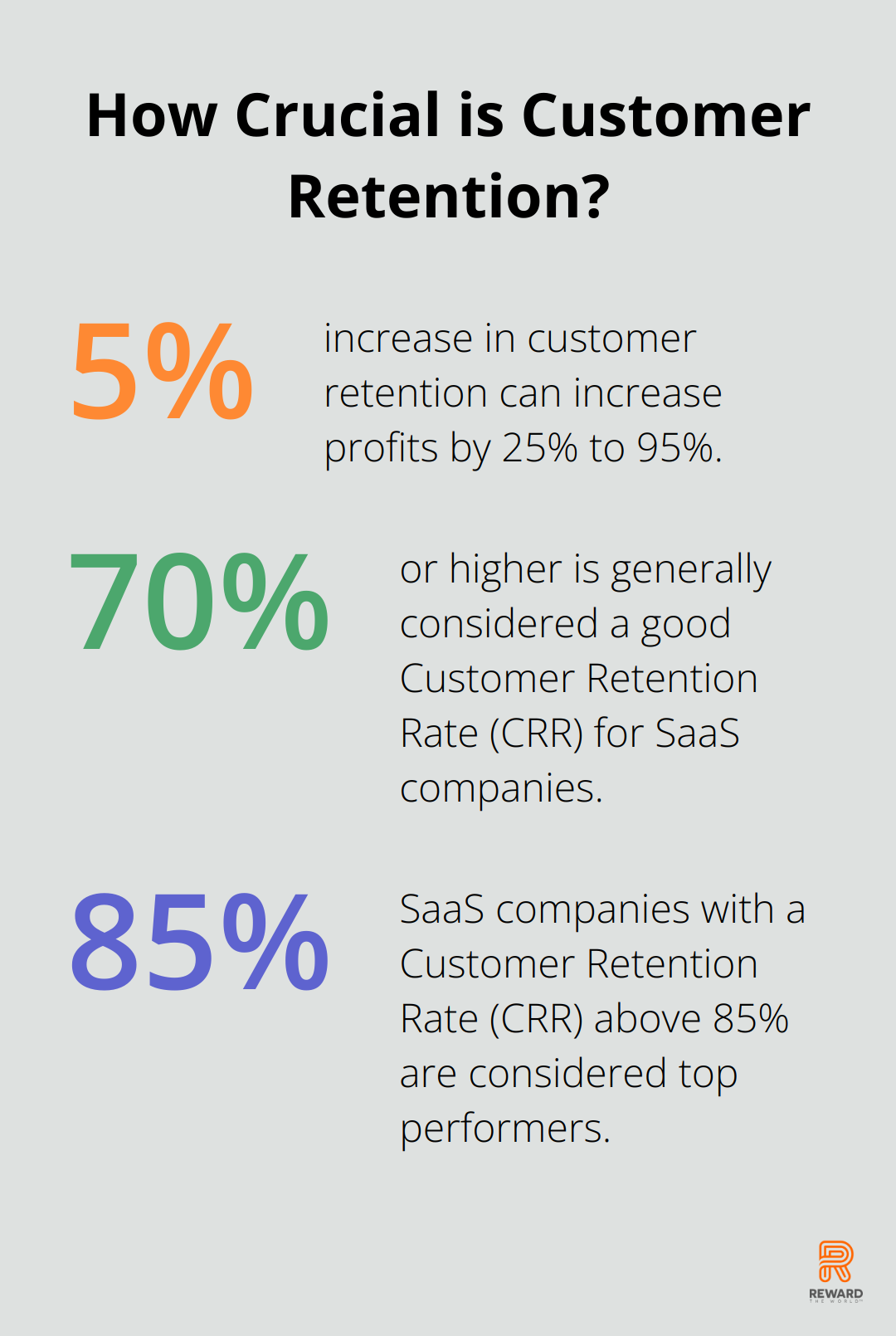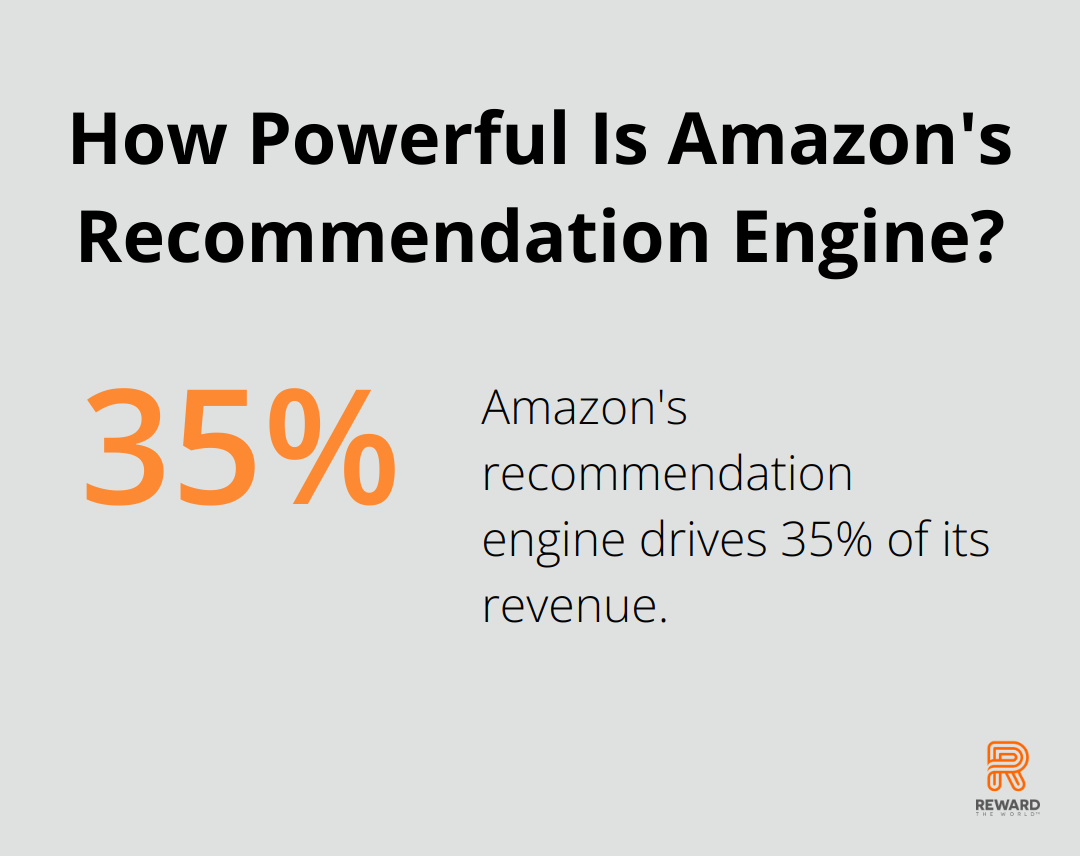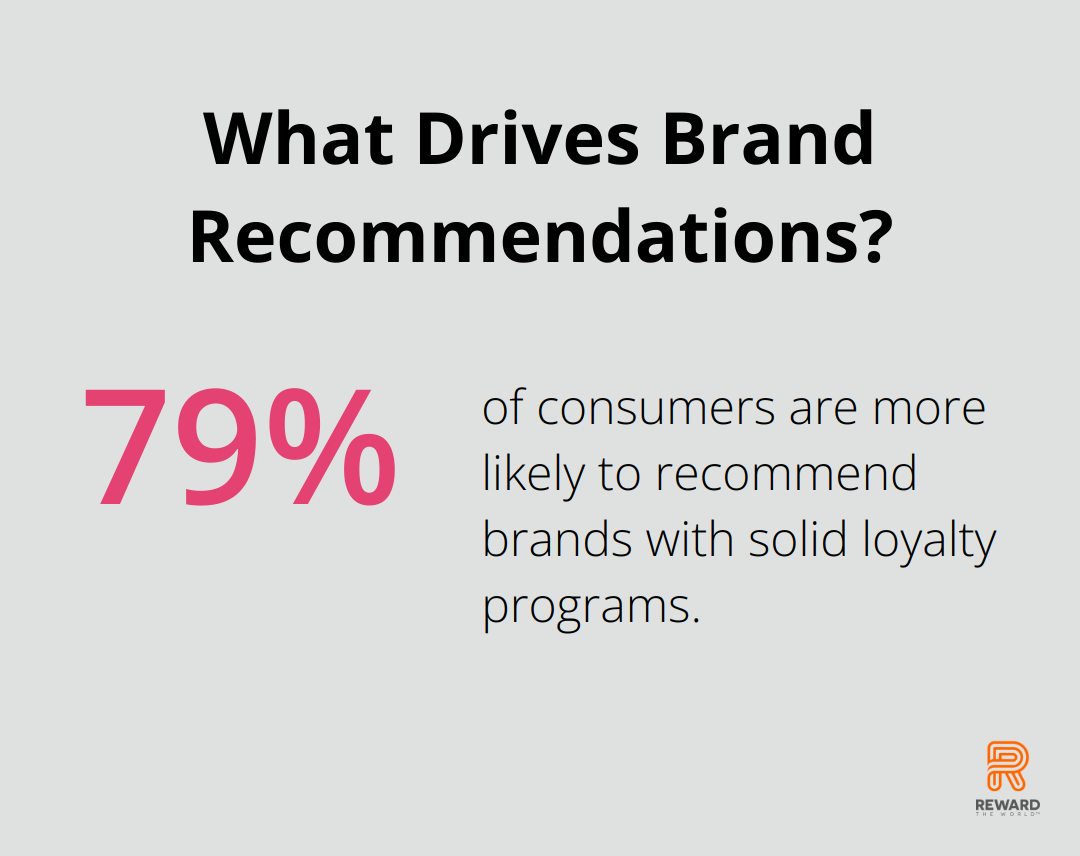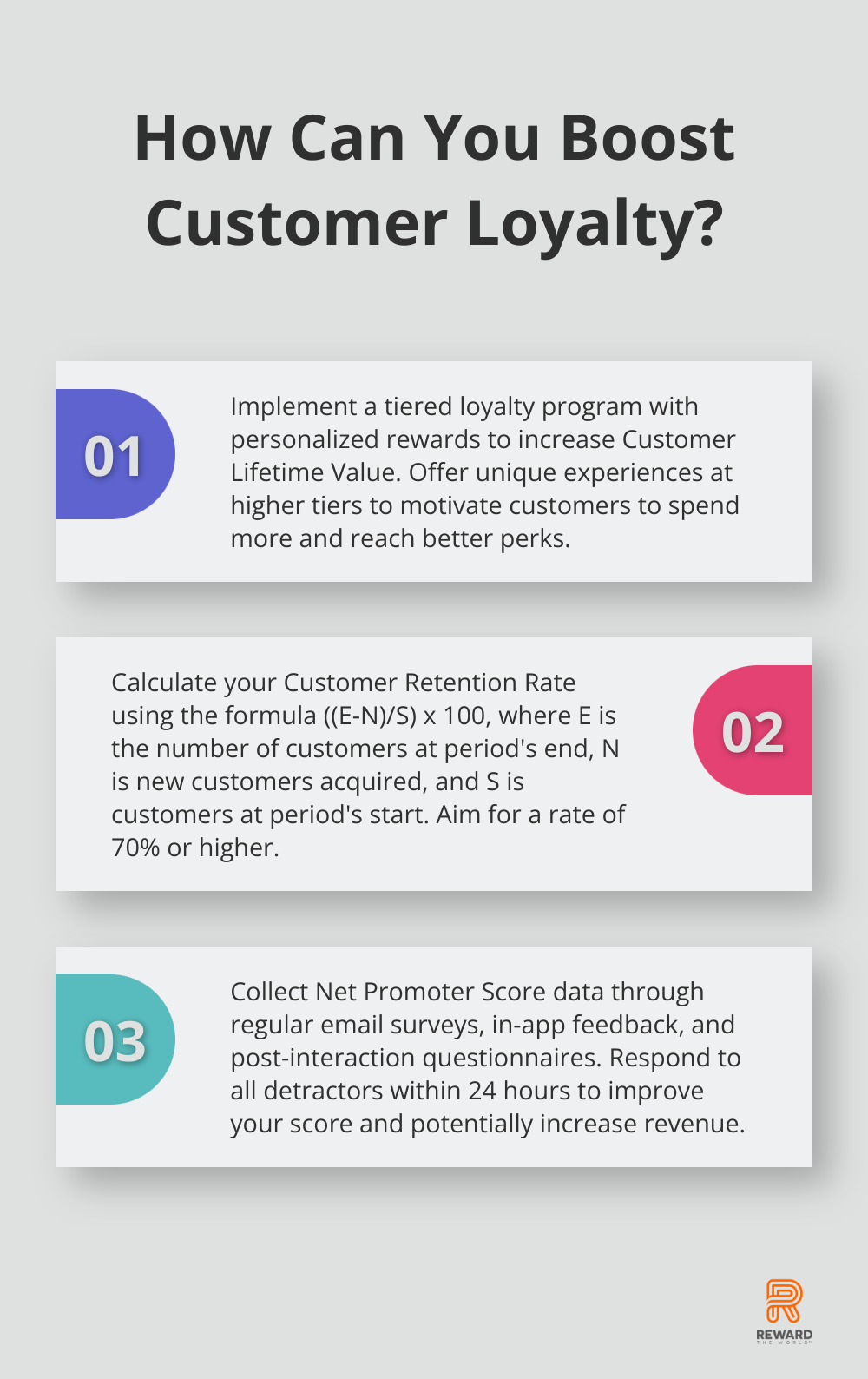Customer loyalty is the backbone of any successful business. At Reward the World, we know that measuring this loyalty is essential for growth and sustainability.
But how do you quantify something as intangible as customer loyalty? The answer lies in key metrics for customer loyalty that provide valuable insights into your customers’ behavior and satisfaction levels.
In this post, we’ll explore three crucial metrics that will help you gauge and improve customer loyalty effectively.
What’s Your Customer Retention Rate?
The Heartbeat of Your Business
Customer retention rate serves as the pulse of your business. It measures the percentage of new customers that stay with your business over a specified period of time. This metric can determine a company’s success or failure.
The Power of Customer Retention
Customer retention rate acts as your business’s loyalty scorecard. It’s not just about keeping customers; it’s about amplifying your profits. A study by Bain & Company found that increasing customer retention by 5% can increase profits by 25% to 95%. This statistic underscores the significant impact of retention on business growth.
How to Calculate Your Retention Rate
The formula for customer retention rate is straightforward:
Customer Retention Rate = ((E-N)/S) x 100
E = Number of customers at the period’s end
N = Number of new customers acquired during the period
S = Number of customers at the period’s start

For example, if you start the year with 1000 customers, gain 200 new ones, and end with 950, your retention rate would be 75%. This indicates you retained 75% of your original customers.
Industry Benchmarks: A Guide, Not a Rule
Retention rates fluctuate across industries. A good CRR for SaaS companies is generally 70% or higher, while those above 85% are top performers. These benchmarks provide context, but shouldn’t be your sole focus. The most important aspect is to improve your own rate consistently.
Strategies to Boost Your Retention Rate
Improving your retention rate involves creating experiences that entice customers to return. Consider these strategies:
- Personalize interactions: Utilize data to customize communications and offers.
- Launch a loyalty program: Incentivize repeat customers to encourage ongoing engagement.
- Collect and act on feedback: Conduct regular surveys to address issues before they result in churn.
The Impact of Smart Loyalty Programs
Businesses can transform their retention rates with well-designed loyalty programs. For instance, a retail sector company saw a 15% increase in retention after implementing a points-based system with personalized rewards.
A high retention rate not only benefits your bottom line but also indicates that you deliver value to your customers. As you track this metric, you’ll build a loyal customer base that propels your business forward year after year.
Now that we’ve explored customer retention rate, let’s turn our attention to another critical metric: Net Promoter Score (NPS). This measure provides valuable insights into customer satisfaction and their likelihood to recommend your business.
What’s Your Net Promoter Score?
Understanding NPS: A Key Loyalty Metric
Net Promoter Score (NPS) stands as a powerful tool for measuring customer satisfaction and predicting business growth. This metric, developed by Fred Reichheld and initially popularized in his 2003 Harvard Business Review article, has been widely adopted by large companies worldwide to gauge customer loyalty and satisfaction.
The Mechanics of NPS
NPS relies on a single question: “On a scale of 0-10, how likely are you to recommend our product/service to a friend or colleague?” Responses fall into three categories:
- Promoters (9-10): Loyal enthusiasts who continue buying and refer others
- Passives (7-8): Satisfied but unenthusiastic customers vulnerable to competitive offerings
- Detractors (0-6): Unhappy customers who can damage your brand through negative word-of-mouth

To calculate your NPS, subtract the percentage of Detractors from the percentage of Promoters. The score ranges from -100 to +100, with higher scores indicating better customer satisfaction and loyalty.
Effective NPS Data Collection and Analysis
Gathering NPS data requires consistency and strategy. Here are effective methods:
- Email surveys: Send regular NPS surveys to your customer base. Try to conduct quarterly or bi-annual surveys to track changes over time.
- In-app or website feedback: Implement NPS questions within your digital platforms for real-time feedback.
- Post-interaction surveys: Ask the NPS question after key customer interactions (e.g., purchases or support calls).
When analyzing NPS data, look beyond the score. Examine trends over time and segment responses by customer demographics, product lines, or touchpoints. This granular analysis can reveal specific areas for improvement.
Strategies to Improve Your NPS
Boosting your NPS requires a company-wide commitment to customer satisfaction. Consider these actionable strategies:
- Close the feedback loop: Respond to all detractors within 24 hours. An increase of the NPS score by 7 points equates to a 1% growth in revenue.
- Empower your frontline: Train customer-facing staff to address issues proactively. Companies like Zappos have built their reputation on exceptional customer service, contributing to high NPS scores.
- Personalize the customer experience: Use data to tailor interactions. Amazon’s recommendation engine (which drives 35% of its revenue) exemplifies effective personalization.
- Innovate based on feedback: Use NPS comments to drive product development. Apple’s high NPS (89 in 2021) partly results from its responsiveness to user feedback in product updates.
- Create a customer-centric culture: Align company goals with NPS improvement. Some firms have tied employee bonuses to NPS scores, incentivizing customer-first thinking across the organization.
Improving your NPS is an ongoing process. It demands consistent effort, analysis, and adaptation. Focus on turning detractors into promoters and passives into enthusiasts to build a loyal customer base that drives sustainable growth.
While NPS offers valuable insights into customer satisfaction, it represents just one piece of the loyalty puzzle. Our next exploration takes us to Customer Lifetime Value (CLV), a metric that helps you understand the long-term profitability of your customer relationships.
What’s Your Customer Lifetime Value?
Understanding CLV: A Key Profitability Metric
Customer Lifetime Value (CLV) stands as a transformative metric that helps businesses understand the total worth of a customer throughout their relationship. This metric enables companies to make informed decisions about customer acquisition and retention strategies.
The Impact of CLV on Profitability
CLV transcends short-term gains, offering a long-term perspective on customer relationships. A study by Bain & Company revealed that a 5 percent improvement in customer retention can increase profits by 25 percent to 95 percent. This striking statistic highlights the profound impact of nurturing enduring customer relationships.
Methods to Calculate CLV
Several approaches exist to calculate CLV, but a straightforward method is:
CLV = (Average Purchase Value x Purchase Frequency x Customer Lifespan)
For instance, if a customer spends an average of $100 per transaction, makes a purchase twice a year, and remains a customer for five years, their CLV would be:

CLV = ($100 x 2 x 5) = $1,000
More sophisticated models incorporate predictive analytics and machine learning to forecast future customer behavior accurately, accounting for factors like acquisition costs and changing purchase patterns.
Leveraging Loyalty Programs to Increase CLV
Loyalty programs serve as powerful tools for boosting CLV. 79% of consumers are more likely to recommend brands with solid loyalty programs. Here are strategies to harness loyalty programs for higher CLV:
- Tiered Rewards: Implement a tiered system that motivates customers to increase their spending to reach higher levels with better perks.
- Personalized Offers: Utilize data analytics to customize rewards to individual customer preferences. (Accenture reports that 91% of consumers prefer to shop with brands that provide relevant offers and recommendations.)
- Experiential Rewards: Offer unique experiences alongside traditional rewards. Sephora’s Beauty Insider program exemplifies this by allowing members to redeem points for exclusive makeup classes.
Enhancing CLV Through Personalization
Personalization plays a key role in increasing CLV. McKinsey reports that personalization can deliver five to eight times the ROI on marketing spend and increase sales by 10% or more. Here’s how to create personalized experiences:
- Data-Driven Insights: Use customer data to understand preferences and behavior patterns. Amazon’s recommendation engine (which drives 35% of its sales) demonstrates effective data utilization.
- Omnichannel Consistency: Provide a seamless experience across all touchpoints. Starbucks excels at this with its mobile app, which integrates ordering, payments, and rewards.
- Proactive Customer Service: Anticipate customer needs before they arise. Netflix’s personalized content recommendations keep subscribers engaged, reducing churn and increasing CLV.
Businesses that focus on CLV shift from short-term transactions to building lasting, profitable relationships. Through sophisticated loyalty programs or personalized experiences, companies create value that keeps customers returning year after year. For businesses seeking to implement effective loyalty programs and boost CLV, Reward the World offers a comprehensive solution that outperforms traditional alternatives.
Final Thoughts
Customer Retention Rate, Net Promoter Score, and Customer Lifetime Value serve as essential metrics for customer loyalty. These indicators provide valuable insights into business health and growth potential. Companies must track these metrics consistently to make informed decisions and adapt strategies to meet evolving customer needs.

Reward the World understands the importance of these metrics in driving business success. Our global incentives platform helps businesses improve customer loyalty, boost sales conversions, and enhance employee recognition. We offer instant reward delivery across various categories, suiting all demographics and budgets.
Customer loyalty extends beyond retention; it creates meaningful, long-lasting relationships benefiting both customers and businesses. Focusing on key metrics and utilizing powerful tools can help build a loyal customer base. This approach propels businesses to new heights of success in today’s competitive market.
